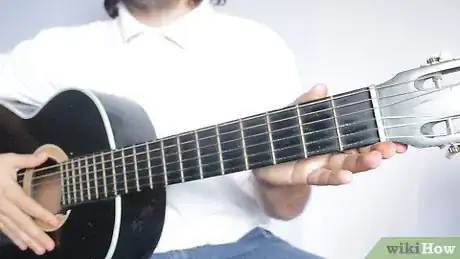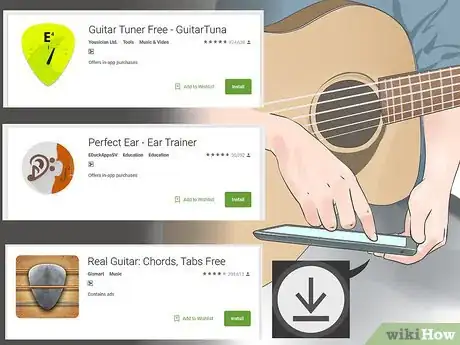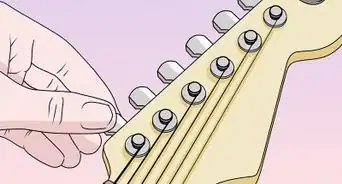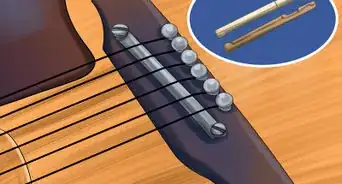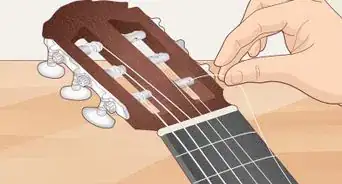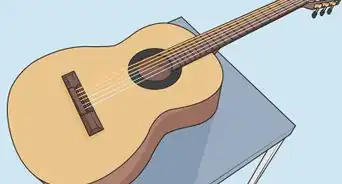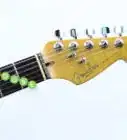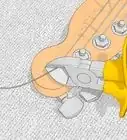This article was co-authored by Ron Bautista. Ron Bautista is a professional guitarist and guitar teacher at More Music in Santa Cruz, California and the Los Gatos School of Music in Los Gatos, California. He has played guitar for over 30 years and has taught music for over 15 years. He teaches Jazz, Rock, Fusion, Blues, Fingerpicking, and Bluegrass.
There are 13 references cited in this article, which can be found at the bottom of the page.
wikiHow marks an article as reader-approved once it receives enough positive feedback. This article received 14 testimonials and 85% of readers who voted found it helpful, earning it our reader-approved status.
This article has been viewed 3,032,153 times.
Learning how to play the guitar is an exciting skill that will impress those around you. If you have a passion for music and the acoustic guitar but don't have a lot of time or the patience to learn how to play, you may want to do it quickly. Although mastering the guitar can take decades, there are techniques and methods that you can use to rapidly learn how to play the basics on acoustic guitar. By learning simple open chords, playing guitar tabs, and practicing regularly and correctly, you'll be able to play the acoustic guitar in no time.
Steps
Getting the Basics Down
-
1Ensure that your guitar is in tune. Get an electronic tuner to make sure that your guitar is tuned. Trying to learn how to play different songs with an untuned guitar can confuse you. Also, many guides that you find online will be using standard tuning.
- Standard tuning starting from the top string to the bottom is E, A, D, g, b, e.[1]
- Play open notes on your guitar and make sure that they correspond with the digital output on the tuner.
-
2Hold your guitar correctly. When you are sitting down, there are two main ways to hold your guitar. For a casual playing style, lay the guitar over your dominant leg. On the other hand, the classical method has you set your guitar on your non-dominant leg. In both instances, make sure that the guitar is held close against your body. Holding your guitar properly makes it easier to play and prevents you from becoming fatigued. Play around with both styles and figure out which one is most comfortable for you.[2]
- The classical style gives you more control over the neck of your guitar.
- The casual style reduces fatigue as you play.
- Make sure that the guitar is upright while you play because tilting the guitar can hurt your wrists.
- When standing, make sure that you have a strap on your guitar and that the guitar is tight against your torso, with the top of the guitar over your chest.[3]
- Maintain a relaxed posture as you play your guitar.
Advertisement -
3Learn the difference between chords and single notes. Chords occur when you play two or more notes on different strings simultaneously to create one unified sound. These are what make up the "rhythm" portion of acoustic music. Single notes are used more for solos and occur when you play a single note at a time. Both are skills that you must become proficient in when learning to play the acoustic guitar.
Learning Simple Open Chords
-
1Learn the basic open chord shapes. Open chords are chords that are played towards the top of your guitar's neck, near the tuning knobs. When playing the acoustic guitar, knowing the open chord shapes is critical to play popular rhythms. Figure out two easy chords, like E minor and A major, for example, to get an understanding of their shape.[4]
- The 8 most common beginner open chords include C, A, G, E, D, Am, Em, and Dm.
- Don't get overwhelmed by the number of different open chords, start off by learning one or two, then move onto more complex open chords.
- The left string on the chord chart refers to the top string on your guitar.
- Your strings are numbered from 1-6 starting from the bottom string, or the 1st string.
EXPERT TIPRon Bautista is a professional guitarist and guitar teacher at More Music in Santa Cruz, California and the Los Gatos School of Music in Los Gatos, California. He has played guitar for over 30 years and has taught music for over 15 years. He teaches Jazz, Rock, Fusion, Blues, Fingerpicking, and Bluegrass.Professional Guitarist & Guitar Instructor
 Ron Bautista
Ron Bautista
Professional Guitarist & Guitar InstructorPro Tip: As you learn basic chord shapes, pay attention to the notes that make up each chord. Try to understand the tones involved in creating the sound of each chord to better train your ear.
-
2Position your fingers on the neck. The dots on the chords represent where you should hold down your fingers on the neck. For instance, an A major is played by holding down the string on the second fret on the 2nd, 3rd, and 4th string. An E minor is played by holding down the second fret on the 5th and 4th string. Hold the strings down until they are pressed against the neck of your guitar.[5]
-
3Strum your guitar with a pick or your fingers. Hold down the strings with your fingers in the appropriate shape and try to strum with your other hand. Acoustic guitar strings often have higher actions than electric guitars, so you may have to press down very hard to get a good sound. If the chord comes out muted, try holding down the strings with more force. If your string is buzzing, move your finger further away from the metal fret on your neck.
- On your chord chart, you'll either have an o or an x over each of your six strings. This designates which strings you should strum and which strings you should not.
- For an A major, you strum all of the strings but the top string.
- For an E minor, you strum all of the strings.
-
4Transition and play both chords in the progression. Now instead of strumming on one chord, practice going back and forth between your E minor and A major. Strum four times up and down on your E minor chord before re-positioning your hand and strumming the A major chord four times, up and down.
-
5Try out different strumming patterns and rhythms. Once you're able to produce a good sounding chord, try strumming it at different tempos and rhythms. Rhythm is based on your strumming pattern, and how long you're holding your notes. Try a basic 1-2-3-4 beat, otherwise known as a 4/4. The number on the top represents how many beats there are in the measure. Try strumming up and down in different progressions to create a different sound for your rhythm. Once you get a basic rhythm down, you can start to incorporate quicker or slower strumming.
- As you play, your fingers might get sore. If this is the case, take a break and come back to practicing later.
EXPERT TIPRon Bautista is a professional guitarist and guitar teacher at More Music in Santa Cruz, California and the Los Gatos School of Music in Los Gatos, California. He has played guitar for over 30 years and has taught music for over 15 years. He teaches Jazz, Rock, Fusion, Blues, Fingerpicking, and Bluegrass.Professional Guitarist & Guitar Instructor
 Ron Bautista
Ron Bautista
Professional Guitarist & Guitar InstructorTry listening to different styles of music for inspiration as you learn to play. If you're trying to learn to play by ear, listen to the blues and try to mimic that sound. Blues progressions are especially great for learning to play guitar because it's built on the basics of music theory. Once you learn those progressions, you can start practicing them in different keys, as well.
Playing Tabs
-
1Use tabs instead of sheet music. If you don't already know how to read music, it can take a lot of time to memorize and proficiently read sheet music. Tabs are an easier and more intuitive way to write music for beginners that doesn't require any formal education. Tabs will simply tell you where to put your fingers on a fret board and how to generally play a song.[6]
- While traditional sheet music can tell you the duration of the notes in a song, tabs require you to listen to the music itself.
- If you're interested in playing other instruments, you should learn how to read music.
-
2Learn how to read tabs. Tabs will have six lines that represent your strings, along with numbers that designate where you should be placing your fingers. The numbers represent the fret in which you need to hold the string down. A 1 means the first fret, a 2 means the second fret, and so on. Numbers in a progression mean that you hold down the first individual fret and pick the note, then move to the next one, and so on in succession. Numbers on the same vertical line are meant to be played together simultaneously as a chord.[7]
- Tabs are read from left to right.
-
3Determine the guitar riff that you want to learn. Listen to acoustic guitar songs that you enjoy and choose one that you'd like to learn. When finding your first song, try to find a song that has an easy chord progression. Listen to the song and determine how many chord changes it has and the speed in which the song is played. If there aren't that many chords or the song seems simple to play, you should choose that song as your first song to learn.
- Easy songs to learn include “Three Little Birds” by Bob Marley, “Hey There Delilah” by the Plain White T’s, and “Upside Down” by Jack Johnson.[8]
-
4Look up the tabs for the song online. Type in the name and artist of the song and look up the tabs in a search engine. Once you find the tabs, you'll be able to see which chords and notes that the artist is using to play the song.
-
5Open up audio for the riff and follow the tabs. Open the song that you're covering in another window on your internet browser. Play through the song and trace the chords and notes with the tab that you looked up. Try to follow the numbers on the tab with the notes that are being played in the song. Try to get an understanding for which chords the artist is playing before trying to duplicating it.
- Listen to the song 3 or 4 times.
-
6Start playing the different notes and hold the different shapes. Once you have a basic understanding of how the notes are played throughout the song, you can start to hold each of the chords. If the song consists of chords that you're used to playing, it will make the process easier. If the song uses different chords, it may take some time and adjustment to get used to them. Practice the chords separately if they are unfamiliar to you.[9]
-
7Divide the song into portions and master each part. If the song's chords and progressions are new to you, it's easier to break the song down into separate parts. Examine the tabs and figure out parts where the chords or rhythm is repetitive. Master each of these individual parts before trying to play the entire song.[10]
- If you are really familiar with the chords that the song is using, you can try playing the song all the way through over the recording of the riff.
-
8Play the song with the audio recording. Once you've mastered the individual portions of the song, you're ready to play the song in its entirety. Play the song and strum your guitar along with the song. Try to keep up with the tempo of the song you're covering. Follow the tabs as you play. If you make a mistake, follow the music on the tabs and come back into the song when you're ready. Once you've become proficient at playing the riff, continue practicing until you don't need the tabs anymore.
- If your guitar sounds different than the track, your guitar may be out of tune, or you may be playing the wrong notes or chords.
- Since tabs are sometimes user-submitted, they aren't always exact.
Increasing Your Skills Quickly
-
1Practice playing individual notes. Holding down a string and producing a decent sound can sometimes be more challenging than it looks. If you don't hold down a string hard enough, you'll get a muted note and if you hold down the string too close to the fret your guitar will buzz. Practice picking in an up and down motion on your string with the other hand. Continue doing this until you feel comfortable moving up or down the neck to a different note. Practice playing the notes back and forth until you become comfortable strumming.
- Practice picking individual notes until you can go all the way up and down the neck of the guitar with ease.
- At first, you're likely to pick the wrong string. Continue to practice until you know where the string is via muscle memory.
-
2Learn how to transition to different chords. One way to become proficient quickly is to learn how to transition between the various chords quickly. These transition periods are often the hardest for beginners to play when they are starting off. The more you practice between switching to different chords, however, the better you'll get at doing it in songs. Practice switching between open chords like G, A, E, and C. [11]
- Take your time and be deliberate when switching from chord to chord.
-
3Practice at least 20 minutes for 6 days a week. Consistent practice will allow you to improve your guitar playing skills over a short period. Taking long breaks and not staying dedicated will wear away your muscle memory and delay the development of your skills. Instead, dedicate 20 minutes to an hour of practice throughout most of the week. During practice, you can either run different drills or you can try covering a song.[12]
- Once you get more comfortable with the guitar and your fingers don't hurt as much, you can make your practice sessions longer.
- Over time, you will start to build callouses on your fingertips and you will be able to play without the pain.
- If you feel pain in your wrist, take a break. Try to re-position it so it doesn't hurt while you play.
-
4Watch videos of guitar tutorials online. There are a variety of different tutorials online that can teach you basic or advanced techniques for the acoustic guitar. Search for lessons on popular websites like YouTube or visit websites that have guitar tutorials for free. The more informal instruction you're able to absorb, the better you'll become.
- Top guitar tutorial sites include Guitar Tricks, Justin Guitar, JamPlay, and ArtistWorks.[13]
-
5Download apps that will help you learn how to play. There are apps that you can download to your mobile device that will help you learn how to play the acoustic guitar. These apps range from step-to-step guides on how to play, to apps that can act as mixers and recorders. Go to the app store for your device and try to find some apps that can help you.
- Top guitar lesson apps include Real Guitar, Perfect Ear, and GuitarTuna.[14]
Community Q&A
-
QuestionHow can I learn to change chords quickly and how long will it take?
 Community AnswerKeep practicing transitioning between chords. Start off slowly, and it will become easier to switch chords faster. If you practice at this for a long time, you could finish in a day, but it really depends on the difficulty level of the chords you are switching to and from.
Community AnswerKeep practicing transitioning between chords. Start off slowly, and it will become easier to switch chords faster. If you practice at this for a long time, you could finish in a day, but it really depends on the difficulty level of the chords you are switching to and from. -
QuestionWhat is an open string?
 Community AnswerAn open string is a string played without pushing down any frets. It is the raw sound of the string.
Community AnswerAn open string is a string played without pushing down any frets. It is the raw sound of the string. -
QuestionHow do you know when you play the right notes?
 Community AnswerWhen you play the right note or chord, you will hear it. It will be a pleasant sound, it will be clear and won't have any blocked string sounds (unless it needs to, but you'll get to that later). To play a note or chord correctly, you have to get your fingers in the right position and press as hard as you can on the frets; it will become a habit if you practice enough.
Community AnswerWhen you play the right note or chord, you will hear it. It will be a pleasant sound, it will be clear and won't have any blocked string sounds (unless it needs to, but you'll get to that later). To play a note or chord correctly, you have to get your fingers in the right position and press as hard as you can on the frets; it will become a habit if you practice enough.
Thing's You'll Need
- Acoustic guitar
- Guitar picks (optional)
- A computer with internet
- Speakers or headphones
References
- ↑ http://howtotuneaguitar.org/tuning/how-to-tune/
- ↑ http://www.guitarlessons.com/guitar-lessons/beginner-guitar-quick-start-series/how-to-hold-the-guitar/
- ↑ https://www.guitartricks.com/lesson/21987
- ↑ http://www.huffingtonpost.com/zachary-stockill/learn-how-to-play-guitar-_b_5503596.html
- ↑ http://www.guitarhabits.com/the-8-most-important-open-guitar-chords-for-beginners/#
- ↑ https://www.ultimate-guitar.com/lessons/for_beginners/how_to_read_tabs.html
- ↑ https://www.ultimate-guitar.com/lessons/for_beginners/how_to_read_tabs.html
- ↑ http://www.guitarworld.com/acoustic-nation-ten-easy-acoustic-guitar-songs-summer
- ↑ https://www.stringkick.com/blog-lessons/learn-songs-riffs-melodies-by-ear
- ↑ http://takelessons.com/blog/practice-guitar-songs-for-kids-z01
- ↑ http://www.guitarhabits.com/10-effective-ways-to-change-chords-easily/
- ↑ https://www.justinguitar.com/en/PC-501-BeginnersPractice.php
- ↑ http://equipboard.com/posts/online-guitar-lessons
- ↑ http://www.makeuseof.com/tag/5-free-apps-learn-play-guitar-android/
About This Article
If you want to rapidly learn to play the acoustic guitar yourself, start by learning 1 or 2 simple chords, like E minor and A major. To play these chords, check a fingering chart, then place the fingers of your left hand on the correct strings on the neck of the guitar, then strum across the body of the guitar with your right hand. If you are left-handed, you will either need to hold the guitar upside-down or learn to play right-handed. Once you have mastered the 2 chords, practice going back and forth between them. Gradually add in more chords as you feel comfortable. If you want to learn how to read tab charts, keep reading the article!


